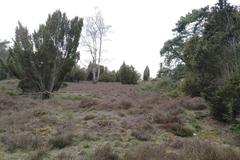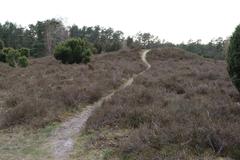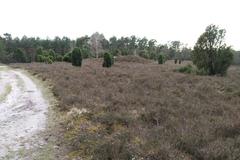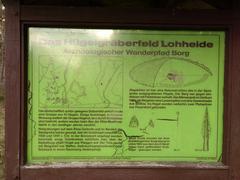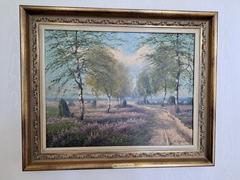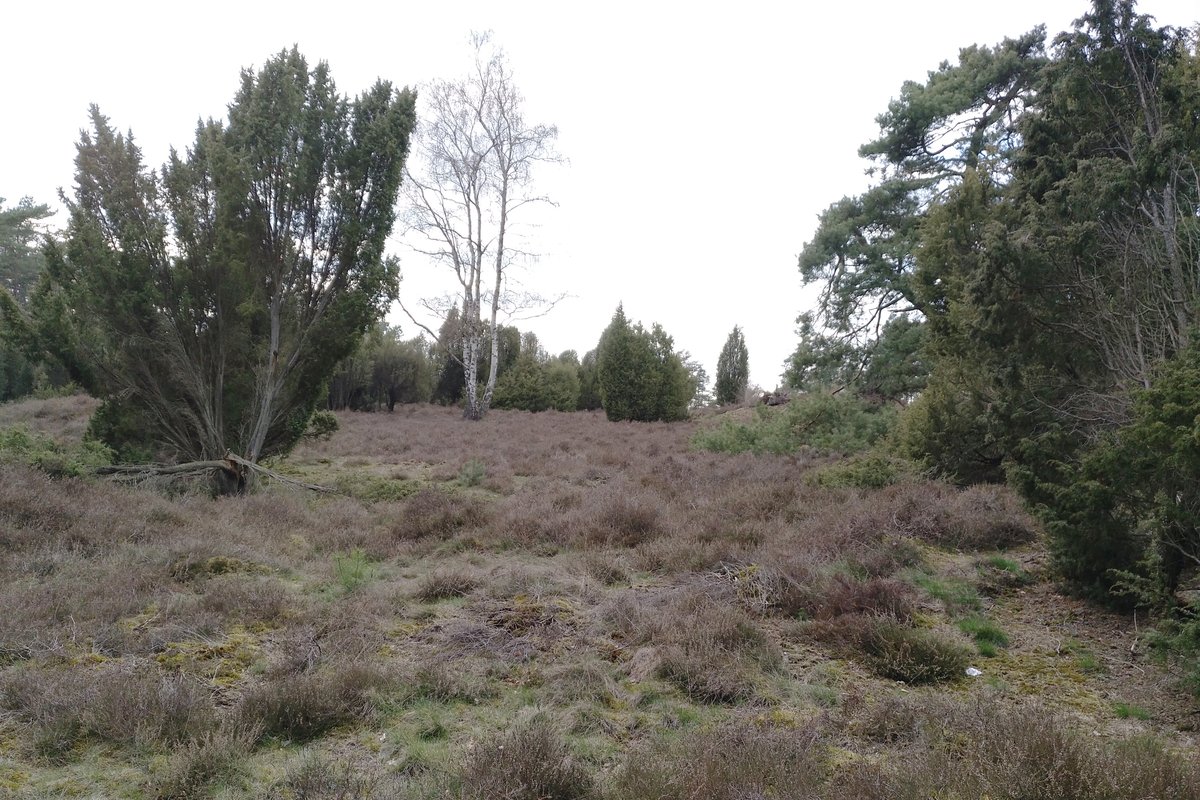
Tumulus Field Lohheide: Visiting Hours, Tickets, and Complete Guide to Walsrode Historical Sites
Date: 14/06/2025
Introduction
Nestled in the scenic expanse of the Lüneburg Heath near Walsrode, Lower Saxony, the Tumulus Field Lohheide offers visitors a captivating journey into Northern Germany’s prehistoric past. This archaeological and natural monument consists of a cluster of ancient burial mounds (tumuli) dating to the Bronze and Iron Ages, standing as enduring markers of early European societies, including the Tumulus Culture and the Nienburg group. Enveloped by rolling heathlands and pine forests, the tumulus field is a year-round destination for history enthusiasts, nature lovers, and travelers seeking to experience the rich tapestry of the region’s heritage.
This guide provides comprehensive information on Tumulus Field Lohheide visiting hours, ticket policies, accessibility, and travel tips. Discover nearby attractions, local festivals, regional cuisine, and practical advice to ensure an enriching visit. Whether you aim to unravel the mysteries of ancient burial traditions or explore the serenity of the Lüneburg Heath, this resource equips you with everything you need for an unforgettable trip.
Consult the Walsrode Tourism Website or Walsrode Tourist Information for the most current updates on opening hours, tours, and events. Enhance your visit by downloading the Audiala app for audio guides and interactive maps.
Table of Contents
- Introduction
- Location and Site Layout
- Visiting Hours and Tickets
- Accessibility and Facilities
- Archaeological and Historical Insights
- Guided Tours and Educational Programs
- Natural Features: Flora, Fauna, and Seasonal Highlights
- Photography and Visual Opportunities
- Practical Visitor Information
- Nearby Attractions and Activities
- Local Culture and Regional Cuisine
- Frequently Asked Questions (FAQ)
- Planning Your Visit
- References and Further Reading
Location and Site Layout
The Tumulus Field Lohheide lies within the Eibia-Lohheide recreational area, just south of Benefeld and Bomlitz, forming part of the greater Walsrode region. Characterized by gently undulating terrain, sandy soils, and sweeping heathlands (Walsrode Wikipedia), the site features a series of low, rounded burial mounds dating from around 1200 to 1500 BCE. Streams and rivers such as the Bomlitz, Warnau, and Böhme define the area’s natural boundaries, supporting a diverse mosaic of habitats (Eibia-Lohheide).
Marked trails loop through the tumulus field, guiding visitors past interpretive signage that explains the burial mounds’ construction and cultural context. Benches and picnic areas provide rest spots amidst the heath.
Visiting Hours and Tickets
- Opening Hours: The site is open year-round, from dawn to dusk. There are no gates or time restrictions, enabling flexible visits.
- Entry Fee: Admission is free, making the tumulus field accessible to all visitors.
- Tickets for Tours: While self-guided visits are always available, expert-led guided tours may require advance booking and a small fee. Check the Walsrode Tourism Website for up-to-date schedules.
Accessibility and Facilities
- Access by Car: Reachable via the B209 or B27 highways. Parking is available at “Parkplatz am Böhmeufer” (south entrance) and “Sportplatz Benefeld” (north).
- Public Transport: Regional buses connect Walsrode to Benefeld and Bomlitz. From there, it’s a short walk to the site (Wikivoyage Walsrode).
- By Bicycle: The area is well-served by cycling routes, making it ideal for bike excursions.
- On-site Facilities: Amenities are limited to benches, picnic spots, and interpretive panels. No restrooms or cafés are located on-site; plan accordingly.
- Accessibility: Main paths are suitable for most visitors, including those with limited mobility, although some terrain near the mounds may be uneven or sandy.
Archaeological and Historical Insights
Tumulus Field Lohheide consists of burial mounds constructed during the Bronze Age (circa 1200–1500 BCE) and later periods. These tumuli served as tombs for high-status individuals and as territorial markers for ancient societies, including the Tumulus Culture and the Nienburg group. Unearthed grave goods—such as bronze and iron artifacts, pottery, and cremation urns—offer a window into the beliefs, social hierarchies, and external contacts of prehistoric communities.
Detailed interpretive panels along the trails illuminate the burial practices, construction methods, and broader cultural significance of the tumuli, making the site a vital part of Walsrode’s heritage (World Heritage Site: Tumuli).
Guided Tours and Educational Programs
Guided tours, led by archaeologists or local historians, are occasionally available—especially during the heather bloom season (late July to early September) and for school or group bookings. These tours provide in-depth historical context and archaeological insights. Educational programs for families and students focus on prehistoric life and excavation techniques. For dates and reservations, consult the Walsrode Tourist Information.
Natural Features: Flora, Fauna, and Seasonal Highlights
Vegetation
The tumulus field is renowned for its sweeping carpets of common heather (Calluna vulgaris), which bloom vibrantly from late July to early September (Heideblüte). Stands of juniper, birch, and pine accentuate the landscape, while stream valleys host wetland flora.
Fauna
Wildlife includes roe deer, wild boar, foxes, and the elusive pine marten. Birdwatchers may spot skylarks, woodlarks, stonechats, and various raptors. Wetland areas attract migratory waterfowl (Eibia-Lohheide).
Climate and Best Visiting Time
The region features a temperate climate with mild summers and cool winters. The highlight is the late summer heather bloom, when the site is at its most colorful and photogenic.
Photography and Visual Opportunities
The tumulus field is a photographer’s delight, especially during the purple heather bloom or at sunrise and sunset when shadows play across the mounds (Tumulus Field Lohheide Images). Visitors are encouraged to stay on marked paths to protect the archaeological features.

Practical Visitor Information
- Dress for the Weather: Layered clothing and waterproofs are recommended, as conditions can change quickly.
- Essentials: Bring water, snacks, and navigation aids since there are no shops or restrooms on-site.
- Site Etiquette: Stay on marked trails, do not climb on the mounds or remove artifacts, and keep dogs leashed.
- Safety: The area is generally safe; however, be prepared for uneven ground in places.
Nearby Attractions and Activities
- Walsrode Bird Park (Weltvogelpark Walsrode): One of the world’s largest bird parks, home to over 4,000 birds. (Walsrode Bird Park)
- Hünenburg: Ancient fortification with scenic trails. (Hünenburg)
- Heilig-Geist-Kirche: Historic church in Benefeld. (Heilig-Geist-Kirche)
- Cordinger Mühle: Picturesque watermill hosting cultural events. (Cordinger Mühle)
- Bergen-Belsen Memorial: WWII memorial and documentation center. (Bergen-Belsen Memorial)
- Lüneburg Heath: Expansive nature reserve famed for its heather bloom. (Lüneburg Heath)
- Grundloser See: Tranquil lake for nature walks and birdwatching. (Grundloser See)
- Rischmannshof Heather Museum: Open-air museum of regional folk crafts. (Rischmannshof Heather Museum)
Local Culture and Regional Cuisine
Traditions and Festivals
Walsrode’s cultural calendar includes harvest festivals, Christmas markets, and bird park events, all offering opportunities to experience regional music, crafts, and cuisine (Germany Expat: Festivals).
Artisanal Heritage
The area is known for woodworking, pottery, and textile traditions, with demonstrations available at the Rischmannshof Heather Museum (Audiala: Walsrode).
Notable Personalities
Famous locals include poet Hermann Löns and Hannover 96 president Martin Kind, celebrated in local museums and cultural events (Audiala: Walsrode).
Cuisine
Enjoy hearty Lower Saxony dishes such as Grünkohl mit Pinkel (kale with smoked sausage), Heidschnuckenbraten (roast heathland lamb), and Kartoffelsuppe (potato soup), often served in local inns (Fluent in Deutsch: Regional Specialties). During festivals, look for street foods like Bratwurst, Currywurst, and Fischbrötchen (Germany Expat: Street Food). Local beer and wines complement these meals, and seasonal treats such as Stollen and Glühwein are highlights during winter markets.
Frequently Asked Questions (FAQ)
Q: What are the visiting hours of Tumulus Field Lohheide?
A: The site is open year-round from dawn to dusk.
Q: Is there an entry fee or ticket required?
A: Admission is free. Guided tours may require tickets.
Q: Are guided tours available?
A: Yes, especially during the heather bloom season and for group bookings. Contact Walsrode Tourist Information.
Q: Is the site wheelchair accessible?
A: Most main trails are accessible, though some areas may be uneven.
Q: Are dogs allowed?
A: Yes, but they must be kept on a leash.
Q: Where are the nearest amenities?
A: Amenities such as restrooms and cafés are available in Walsrode and neighboring villages.
Planning Your Visit
- Download the Audiala app for audio guides and interactive maps.
- Check the Walsrode Tourism Website for current information.
- Combine your visit with neighboring attractions for a full-day or multi-day itinerary.
- For further details, see the Walsrode Wikivoyage page.
References and Further Reading
- Visiting the Tumulus Field Lohheide: Hours, Tickets, and Historical Insights in Walsrode, 2025 (Walsrode Tourism)
- Visiting Tumulus Field Lohheide: Hours, Tickets, and Walsrode Historical Sites Guide, 2025 (Walsrode Wikipedia)
- Tumulus Field Lohheide Visiting Hours, Tickets, and Travel Guide to Walsrode Historical Sites, 2025 (Walsrode Tourist Information)
- Tumulus Field Lohheide Visiting Hours, Tickets & Nearby Attractions in Walsrode, 2025 (Audiala: Walsrode)
- Lüneburg Heath Nature and Attractions, 2025 (Eibia-Lohheide)
- World Heritage Site: Tumuli
- Fluent in Deutsch: Regional Specialties
- Germany Expat: Festivals
